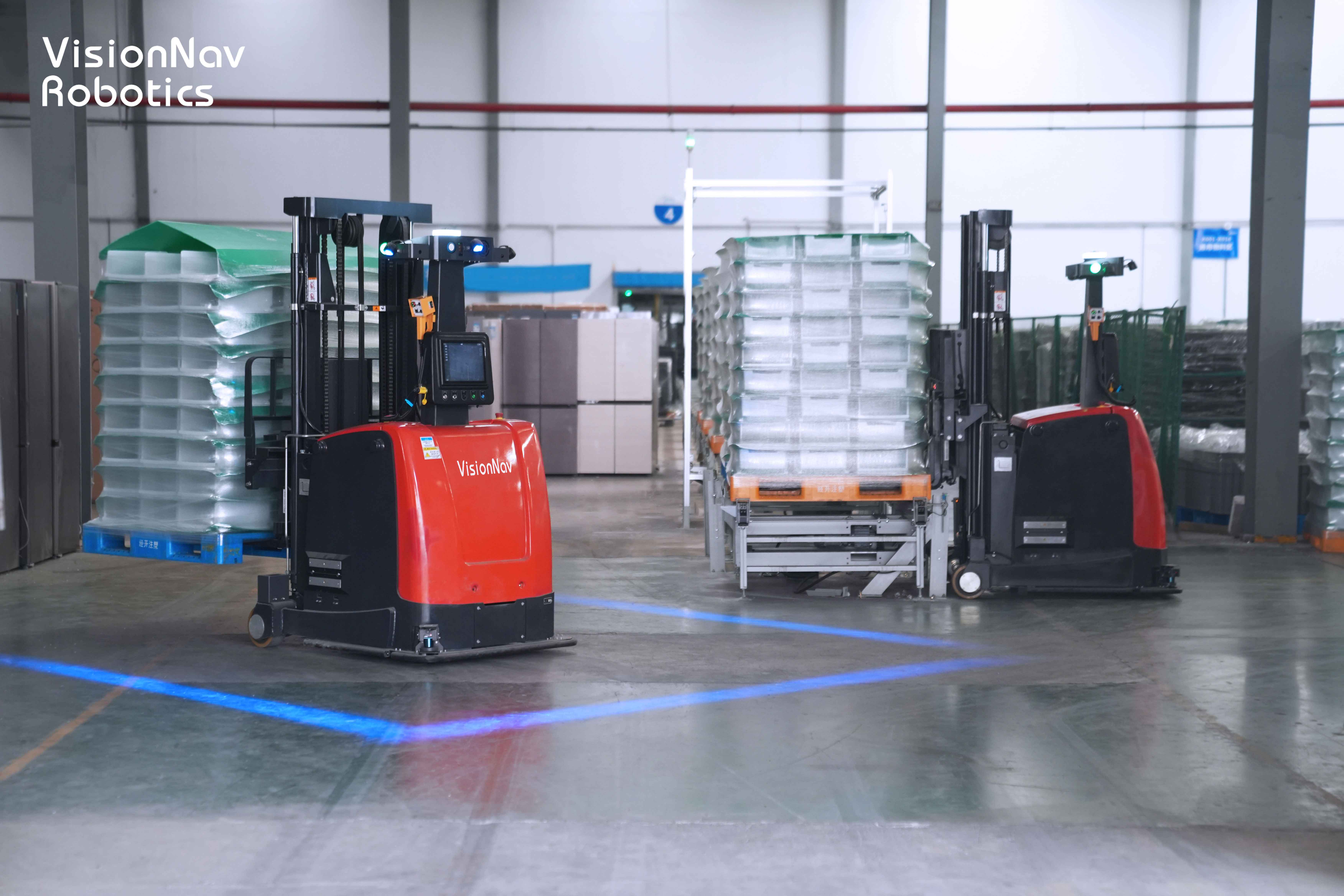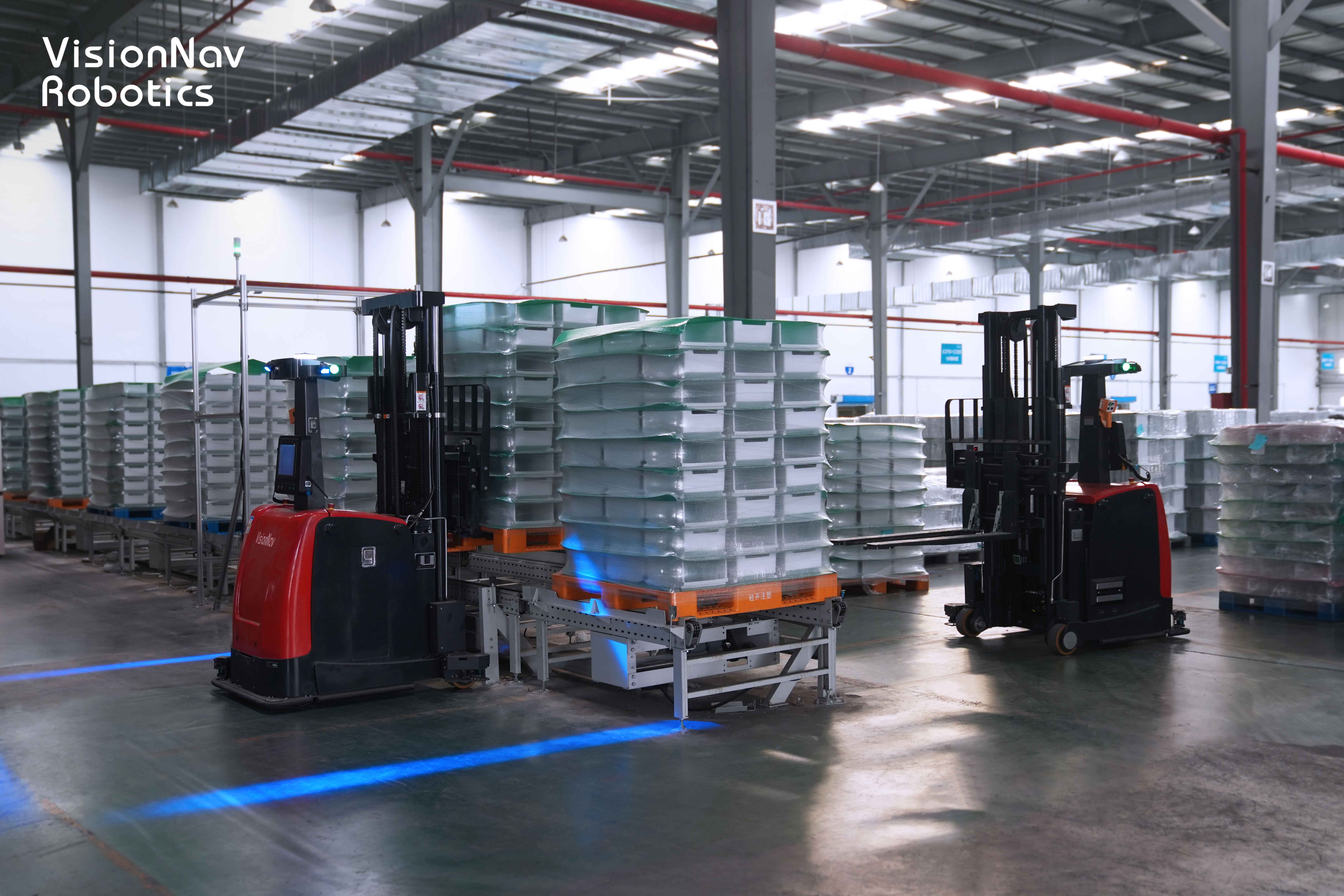Engined by the successful deployment in the energy, petrochemical, tobacco, and communication equipment industries, VisionNav strives for the outdoor/semi-outdoor logistics scene with solid technical research and development capabilities, first-hand, and rich project experience. It is expected to provide solutions and comprehensive services for more users in machinery manufacturing, new energy, 3PL, building materials, and other industries in the coming days.
Our client is a Fortune 500 home appliance manufacturer with production and manufacturing bases in many countries. One of their warehouses urgently needs to deploy the autonomous loading workflow to replace the sluggish logistic in light of the process from the conveyor line to the flatbed truck.
Challenges
Challenge 1: The project scene includes a flatbed truck with a compartment size of 269 inches*93 inches. The working site is flexible with a constant change of the truck position. The weather condition is also one of the obstacles for outdoor loading and unloading.
Challenge 2: The floor of the carriage is uneven. If the system perceives the wrong truck , it will cause cargo collision, failed loading, etc. In addition, the autonomous forklift needs to load the goods safely and ensure a safe space between materials.
Challenge 3: The VNP15 autonomous forklift needs to connect with the conveyor line and the flatbed truck successively and cooperate with the delivery time of the goods to meet the customer's loading speed. The process requires high requirements for the supplier's system feedback efficiency and task planning capabilities.

Dual-vehicle successively working scene
Solution
In response to the needs of the outdoor flatbed truck loading scene, VisionNav proposed a full-process solution of "conveyor line + autonomous loading." By configuring two VNP15 counterbalance stacker AGVs with a self-developed RCS central control-schedule system and Bright Eye truck detection system, so our client can realize production line horizontal transfer with dual vehicles onsite and autonomous truck loading to the flatbed truck.
Advantages
The Bright Eye truck detection system is self-developed by VisionNav. It is based on 3D vision and image recognition technology which can realize the precise positioning and measurement of the vehicle under a broad view and quickly extracts the accurate size and position of multiple parts of the car. It then can give feedback to the RCS central control system, thus assisting the VNP15 autonomous forklift in completing material loading.
VisionNav Robotics' RCS central control system and the Bright Eye truck detection system cooperate, assisting VNP15 autonomous forklifts in yielding an efficient loading strategy.

VNP15 shuttles between the conveyor and the flatbed truck
Procedure
Docking the conveyor and picking up the goods safely: the RCS system can dock with the photoelectric module of the conveyor line. When goods arrive on the conveyor line, the photoelectric module of the conveyor line can sense whether the goods are in a fork-able state (for example, whether the goods have arrived at the designated position, whether the goods are in the Stop state, whether the fork-in surface of the three base pallet on the conveying line is perpendicular to the conveying direction, etc.) and can send the information to the RCS system. The RCS system will then issue a pick-up task and dispatch the VNP15 autonomous forklift to the conveyor line to fork the goods.

VNP15 forks goods from the conveyor
Docking the flatbed truck: when the flatbed truck arrives at the designated location, VisionNav's Bright Eye system can detect the truck status, including the type, location, and storage space of the truck, then send the information to the RCS system. This process helps the RCS system yield efficient loading solutions in real-time, thus outputting the optimal dynamic path to VNP15 autonomous forklifts.

VNP15 is docking the flatbed
Dual-vehicle collaboration: in this project, two VNP15 autonomous forklifts shuttle between the conveyor line and a flatbed truck according to the instructions given by RCS. When the VNP15 autonomous forklift receives the type, location, and storage space information of the flatbed truck from the RCS system, it can control the fork and complete the loading process efficiently based on high-precision intelligent perception and servo control technology.

Dual-vehicle collaboration
Highlights
Highlight 1: There are many uncertain factors in the outdoor loading scene, such as weather conditions, light changes, etc. The Bright Eye detection system has substantial anti-interference advantages in outdoor environments based on 3D laser radar. It can accurately obtain point cloud image information of objects despite all the changes and uncertainties.
Highlight 2: The biggest challenge in the autonomous loading of flatbed trucks is measuring the cargo space in the truck compartment, also under the premise of ensuring the safe placement of the cargo, reducing the gap between the load to improve storage efficiency. With the help of 3D laser perception technology, the Bright Eye truck detection system obtains the 3D point cloud image of the truck. Then it projects the cargo space of the flat-bed truck with the help of image recognition technology and algorithm function. Meanwhile, Bright Eye connects with the RCS central control system to assist the VNP15 autonomous forklift narrow the cargo gap within 50mm laterally and 100mm vertically.
Highlight 3: From indoor warehousing to outdoor loading, the key factors influencing the efficiency of the process are the highly automated forklifts and a stable central control and truck detection system. The RCS central control scheduling system is connected to the conveyor line. It cooperates with the Bright Eye truck detection system to assist the VNP15 in picking up the goods from the conveyor line to the truck loading, achieving a loading efficiency of 10 pallets/15min.
Business Contact
info@visionnav.com
Media Contact
Iris
Marketing Manager
xchen@visionnav.com